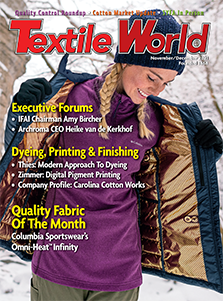The U.S. Grains Council, Washington, D.C., along with Cargill-Dow Polymers and the Kanebo spinning company, Japan, are spearheading a drive to introduce to U.S. consumers, a new and innovative kind of fabric that is made of corn.
Polylactic acid fiber (PLA) was unveiled at the U.S. Grains Council’s Value-Enhanced Grains Conference held recently in Orlando, Fla. There, Kanebo held a fashion show that introduced a variety of clothes made from PLA blended with other fabrics. All of the clothing was designed by
Masako Oka, one of Japan’s leading fashion designers.
Ecologically Sound
The theme of Kanebo’s fashion show was “Fashions for the Earth,” a theme that highlighted PLA’s most unique feature — its environmental friendliness.
PLA is a completely biodegradable synthetic fiber. According to the Grains Council, when the fabric is discarded, soil and sea microorganisms break the material down into carbon dioxide and
water.
Even when incinerated, PLA does not release any harmful gases such as dioxin. According to Kanebo, this makes it an ideal synthetic fiber for the new century because it turns into natural substances through non-polluting processes. This feature is extremely important in Japan, because the country has a significant waste disposal problem. The government is taking drastic measures to try to solve that problem.
According to Dennis Kitch, the Grains Council’s director in Japan, the Japanese market for recycled products is saturated. Because of this, Japan is working to develop packaging alternative, such as biodegradable plastics.

A wedding dress made of 100-percent polylactic acid corn fiber
(Photo courtesy of The U.S. Grains Council).
Bold Fashion Frontiers
At the same time Japan was trying to develop packaging alternatives, U.S. producers and agribusinesses were working to find new uses for U.S. corn, an abundant product.
在过去的两年中,嘉吉 - 唐聚合物从融化的旋转聚乳酸产生了PLA,该聚合物是通过玉米淀粉发酵产生的乳酸的聚合物。他们在Kanebo Company找到了PLA的买家,该公司也一直在研究织物中玉米纤维的使用。两家公司发现,当与棉花或羊毛混合时,PLA被证明是一种丝般但耐用的面料,适用于各种服装,从T恤到适合夹克,甚至
wedding gowns.
PLA has similar properties of existing synthetic fibers and has enough durability under normal use. It has luster and feels like silk. It also has quick-drying properties and is wrinkle resistant.
Future Benefits
According to the Grains Council, if PLA fabrics are adopted, the result could be a significant new market for U.S. corn growers. Use of the fabric may already be poised to take off in Japan.
Kitch said that Japan’s food service and restaurant industry may contract with Kanebo to develop standardized uniforms. If that happens, Kitch reports that the industry could need as many as one million uniforms a year.
PLA can be processed into staple fibers, chopped fibers, multi-filaments, monofilaments and spunbond. This means it can be used in agriculture and landscaping applications such as plant mats and nets to protect young trees from animals, as well as applications including sanitary and
medical products and food packaging materials.
June 1999




